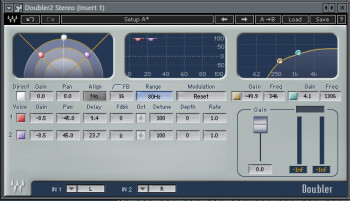After having explored depth with reverb, we will now move into another topic that is just as important during mixdown: width.
Why?
It seems it was ages ago when we placed the different instruments in the stereo field with the help of the pan pots. But remember, the only thing these knobs do is send the signal with more or less volume to either channel to achieve what’s called the interaural intensity difference (IID). And yet, the way your ears and brain locate a sound in the lateral plane has to do with some other phenomena which add a bit more complexity to the equation. Apart from the difference in volume perceived by each of your ears, the speed at which sound travels in the air results in a delay which is also grasped by the ears. This is called interaural time difference (ITD).
On the other hand, the travel of sound in the air inevitably causes alterations to the audio spectrum, just like when it bumps into the unavoidable obstacle you have above the shoulders. This is called interaural spectral difference (ISD).
And these are all things you should take into account if you wish to have a more open and realistic stereo image.
How?
I’ll use an example to show you how this can be done. Imagine that you have a guitar you want to place on the left of the mix. The first thing you do is turn the pan to the left, obviously. But to get more convincing results you should pan the guitar hard left and send the signal to an aux bus whose pan is set hard right. Next, place a delay on the aux bus without feedback and with just a couple of milliseconds of delay, 20 at the most. The longer the delay, the wider the effect will sound. To get even more realistic results, EQ this aux bus to trim the high end of the spectrum with a shelving filter.
Now you should be able to place the guitar anywhere from the center to the left end of the stereo field much more convincingly than with the pan knob by playing with the volume, delay time and EQ of this aux bus.
Final remarks
Before I finish, there are a couple of things you should consider when using this technique. First of all, to place another instrument on the opposite side you’ll obviously need another aux bus panned hard left whose signal is delayed as well.
And also note that this method will inevitably result in mono compatibility issues. However, since you will most usually sub-mix this bus, the most harmful effects ought to be minimized. It’s up to you to call the shots and make trade-offs considering what’s best for the song.
Another thing you should take into account is that it’s not good to use this technique on all the tracks of a mix. Personally, I only use it on two or three important elements at a time. The pan pot is more than enough for the rest.
Finally, I invite you to reread the articles that focus on reverb and the dichotomy between width and depth, as well as the notion of contrast in a mix. They are quite pertinent to today’s topic.
More on this next week!

